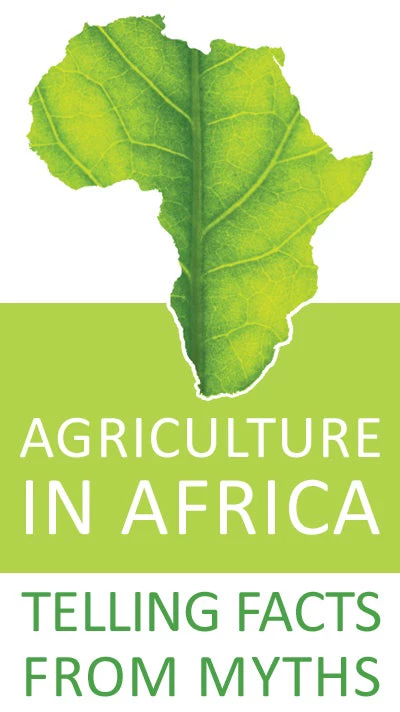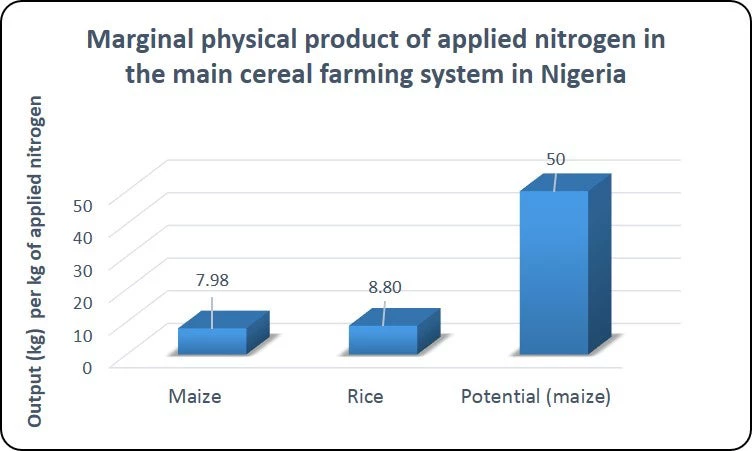
Inorganic fertilizer use is claimed to be low in sub-Saharan Africa, but it is unclear whether using higher rates of fertilizer would be profitable. My coauthors and I sought to explore the effect of nitrogen on maize in farms across Nigeria to find out. To do this, we took advantage of the recently available Living Standards Measurement Study - Integrated Surveys on Agriculture, or LSMS-ISA, a household survey project working to collect up to date agricultural data for the same household over time.
What did we find?
Low yield response and high transport costs reduce fertilizer profitability
We found that little extra maize production is expected from adding more nitrogen at the margin; that is, the marginal physical product (MPP) of applied nitrogen for maize production in Nigeria is quite low at 8kg. Though within the range found in peer-reviewed published works, often between 7 and 14 kg, it is much lower than the potential yield response from plots on which research management protocols are being followed. These range between 14 to 50 kg maize per kg nitrogen (N) and even higher in some cases (Snapp et al, 2014). This low yield response to nitrogen in Nigeria extends to other cereals such as rice (See figure 1).
Figure 1.

Low yield response to inorganic fertilizer use is not a new finding. However, it is not featured very prominently in most policy and socio- economic research discussing the limited use of fertilizer in Africa. Since the Abuja declaration in 2006, renewed efforts to stimulate fertilizer use included an increase and expansion of fertilizer subsidy programs. While soil nutrient depletion is recognized, the response to this needs to extend beyond the current one, which emphasizes increasing the quantity of fertilizer used by farmers to replenish the soils to a more nuanced approach which incorporates complementary inputs and practices necessary to increase the efficiency of fertilizer and its consequent profitability.
High acquisition costs which include both the market price plus transportation costs, also limit the profitability of nitrogen application. Farmers in Nigeria face high transportation costs when traveling to get fertilizers from agro-dealers or community markets. This is largely driven by poor rural infrastructure and far distances.
Reducing Transport Costs vs. Increasing Subsidies
Two natural policy responses to reducing the acquisition cost of fertilizer in rural Nigeria would be to reduce the price of fertilizer through fertilizer subsidies and reducing transportation costs for farmers. Growing evidence on fertilizer subsidy programs indicate that while under certain circumstances, they can be used to increase fertilizer use more generally (Xu et al. 2009; Liverpool-Tasie, 2014), careful attention must be paid to reduce potential inefficiencies and prevent distortionary effects of such programs on private sector activity and demand (Ricker-gilbert et al; 2011; Mason and Jayne, 2013; Takeshima and Nkonya, 2014).
Reducing transportation costs faced by smallholders in rural Nigeria could be achieved with improved rural infrastructure and strategies to reduce the distance farmers travel to purchase fertilizer and other inputs. Indeed, it is key that governments fulfill their role to provide the necessary infrastructure which would minimize transportation costs. However, there is empirical evidence from some previous work that strategies and programs to link agro-dealers with farmers in rural areas and reduce the distance farmers have to go to get the input could also significantly increase fertilizer demand. This lowers the cost and increases the profitability of fertilizer use.
Going forward:
Increasing the use of modern inputs including fertilizer is key for raising agricultural productivity and reducing poverty in Africa. However, simply increasing the quantity of fertilizer used by smallholders is not likely to successfully drive this process. A more holistic approach which includes complementary inputs such as improved seeds and irrigation and practices of timing fertilizer application, weeding and pest control, crop rotation and intercropping is necessary. Attention to the benefits of soil organic matter and soil chemical properties are also essential to increase the efficiency and profitability of applying fertilizers such as nitrogen. Further research is needed to better understand these factors and develop policies that endorse a comprehensive approach to boosting agricultural productivity through the increased use of modern technologies like fertilizer.
Reference:
Liverpool-Tasie, L.S.O, B. T.Omonona, A. Sanou and W. Ogunleye (2015). Is Increasing Inorganic Fertilizer Use in Sub-Saharan Africa a Profitable Proposition? Evidence from Nigeria. World Bank Policy Research Working Paper No 7021
Liverpool-Tasie, Lenis. Saweda. O. (2014), Fertilizer subsidies and private market participation: the case of Kano State, Nigeria. Agricultural Economics. 45:6
Mason, N. and T.S. Jayne. 2013. “Fertiliser subsidies and smallholder commercial fertiliser purchases: Crowding out, leakage, and policy implications for Zambia.” Journal of Agricultural Economics 64 (3): 558-582.
Ricker-Gilbert, J., T. Jayne, and E. Chirwa. 2011. Subsidies and Crowding Out: ADouble-Hurdle Model of Fertilizer Demand in Malawi. American Journal of Agricultural Economics. 93(1): 26-42.
Sieg Snapp, T.S. Jayne, Wezi Mhango, Todd Benson and Jacob Ricker-Gilbert. Maize-Nitrogen response in Malawi’s smallholder production systems. Paper prepared for the National Symposium “Eight Years of FISP – Impact and What Next?” Bingu International Conference Centre, Lilongwe, 14 – 15 July 2014
Takeshima, H., & Nkonya, E. (2014). Government fertilizer subsidy and commercial sector fertilizer demand: Evidence from the Federal Market Stabilization Program (FMSP) in Nigeria. Food Policy, 47, 1-12
Xu, Z., Z. Guan, T.S. Jayne, and R. Black. 2009. Factors influencing the profitability of fertilizer use on maize in Zambia. Agricultural Economics, 40: 437–446. doi: 10.1111/j.1574-0862.2009.00384.
This is the fifth of a series of blogs dissecting our commonly held beliefs about Africa’s agriculture and its farmers. They draw on the findings of the Agriculture in Africa – Telling Facts from Myths partnership project led by the Chief Economist Office of the Africa Region of the World Bank.





Join the Conversation